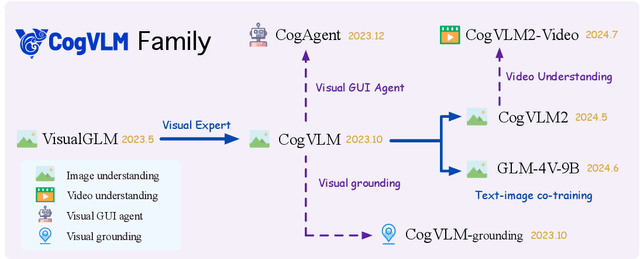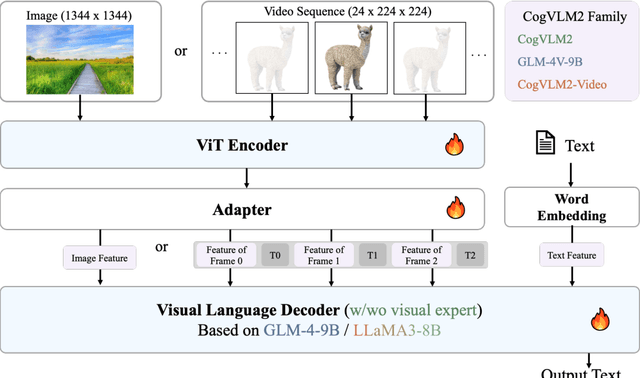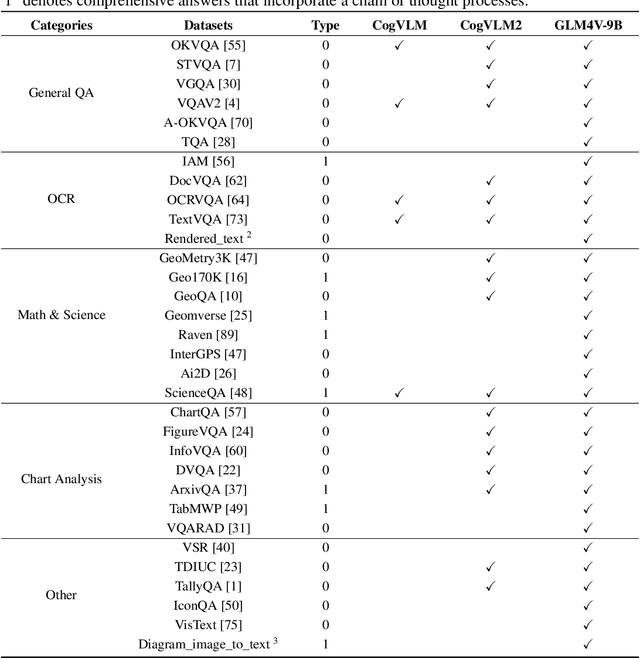Xiaotao Gu
VPO: Aligning Text-to-Video Generation Models with Prompt Optimization
Mar 26, 2025Abstract:Video generation models have achieved remarkable progress in text-to-video tasks. These models are typically trained on text-video pairs with highly detailed and carefully crafted descriptions, while real-world user inputs during inference are often concise, vague, or poorly structured. This gap makes prompt optimization crucial for generating high-quality videos. Current methods often rely on large language models (LLMs) to refine prompts through in-context learning, but suffer from several limitations: they may distort user intent, omit critical details, or introduce safety risks. Moreover, they optimize prompts without considering the impact on the final video quality, which can lead to suboptimal results. To address these issues, we introduce VPO, a principled framework that optimizes prompts based on three core principles: harmlessness, accuracy, and helpfulness. The generated prompts faithfully preserve user intents and, more importantly, enhance the safety and quality of generated videos. To achieve this, VPO employs a two-stage optimization approach. First, we construct and refine a supervised fine-tuning (SFT) dataset based on principles of safety and alignment. Second, we introduce both text-level and video-level feedback to further optimize the SFT model with preference learning. Our extensive experiments demonstrate that VPO significantly improves safety, alignment, and video quality compared to baseline methods. Moreover, VPO shows strong generalization across video generation models. Furthermore, we demonstrate that VPO could outperform and be combined with RLHF methods on video generation models, underscoring the effectiveness of VPO in aligning video generation models. Our code and data are publicly available at https://github.com/thu-coai/VPO.
Concat-ID: Towards Universal Identity-Preserving Video Synthesis
Mar 18, 2025Abstract:We present Concat-ID, a unified framework for identity-preserving video generation. Concat-ID employs Variational Autoencoders to extract image features, which are concatenated with video latents along the sequence dimension, leveraging solely 3D self-attention mechanisms without the need for additional modules. A novel cross-video pairing strategy and a multi-stage training regimen are introduced to balance identity consistency and facial editability while enhancing video naturalness. Extensive experiments demonstrate Concat-ID's superiority over existing methods in both single and multi-identity generation, as well as its seamless scalability to multi-subject scenarios, including virtual try-on and background-controllable generation. Concat-ID establishes a new benchmark for identity-preserving video synthesis, providing a versatile and scalable solution for a wide range of applications.
StepMathAgent: A Step-Wise Agent for Evaluating Mathematical Processes through Tree-of-Error
Mar 13, 2025Abstract:Evaluating mathematical capabilities is critical for assessing the overall performance of large language models (LLMs). However, existing evaluation methods often focus solely on final answers, resulting in highly inaccurate and uninterpretable evaluation outcomes, as well as their failure to assess proof or open-ended problems. To address these issues, we propose a novel mathematical process evaluation agent based on Tree-of-Error, called StepMathAgent. This agent incorporates four internal core operations: logical step segmentation, step scoring, score aggregation and error tree generation, along with four external extension modules: difficulty calibration, simplicity evaluation, completeness validation and format assessment. Furthermore, we introduce StepMathBench, a benchmark comprising 1,000 step-divided process evaluation instances, derived from 200 high-quality math problems grouped by problem type, subject category and difficulty level. Experiments on StepMathBench show that our proposed StepMathAgent outperforms all state-of-the-art methods, demonstrating human-aligned evaluation preferences and broad applicability to various scenarios. Our data and code are available at https://github.com/SHU-XUN/StepMathAgent.
LongSafety: Evaluating Long-Context Safety of Large Language Models
Feb 24, 2025Abstract:As Large Language Models (LLMs) continue to advance in understanding and generating long sequences, new safety concerns have been introduced through the long context. However, the safety of LLMs in long-context tasks remains under-explored, leaving a significant gap in both evaluation and improvement of their safety. To address this, we introduce LongSafety, the first comprehensive benchmark specifically designed to evaluate LLM safety in open-ended long-context tasks. LongSafety encompasses 7 categories of safety issues and 6 user-oriented long-context tasks, with a total of 1,543 test cases, averaging 5,424 words per context. Our evaluation towards 16 representative LLMs reveals significant safety vulnerabilities, with most models achieving safety rates below 55%. Our findings also indicate that strong safety performance in short-context scenarios does not necessarily correlate with safety in long-context tasks, emphasizing the unique challenges and urgency of improving long-context safety. Moreover, through extensive analysis, we identify challenging safety issues and task types for long-context models. Furthermore, we find that relevant context and extended input sequences can exacerbate safety risks in long-context scenarios, highlighting the critical need for ongoing attention to long-context safety challenges. Our code and data are available at https://github.com/thu-coai/LongSafety.
HPSS: Heuristic Prompting Strategy Search for LLM Evaluators
Feb 18, 2025Abstract:Since the adoption of large language models (LLMs) for text evaluation has become increasingly prevalent in the field of natural language processing (NLP), a series of existing works attempt to optimize the prompts for LLM evaluators to improve their alignment with human judgment. However, their efforts are limited to optimizing individual factors of evaluation prompts, such as evaluation criteria or output formats, neglecting the combinatorial impact of multiple factors, which leads to insufficient optimization of the evaluation pipeline. Nevertheless, identifying well-behaved prompting strategies for adjusting multiple factors requires extensive enumeration. To this end, we comprehensively integrate 8 key factors for evaluation prompts and propose a novel automatic prompting strategy optimization method called Heuristic Prompting Strategy Search (HPSS). Inspired by the genetic algorithm, HPSS conducts an iterative search to find well-behaved prompting strategies for LLM evaluators. A heuristic function is employed to guide the search process, enhancing the performance of our algorithm. Extensive experiments across four evaluation tasks demonstrate the effectiveness of HPSS, consistently outperforming both human-designed evaluation prompts and existing automatic prompt optimization methods.
MotionBench: Benchmarking and Improving Fine-grained Video Motion Understanding for Vision Language Models
Jan 06, 2025Abstract:In recent years, vision language models (VLMs) have made significant advancements in video understanding. However, a crucial capability - fine-grained motion comprehension - remains under-explored in current benchmarks. To address this gap, we propose MotionBench, a comprehensive evaluation benchmark designed to assess the fine-grained motion comprehension of video understanding models. MotionBench evaluates models' motion-level perception through six primary categories of motion-oriented question types and includes data collected from diverse sources, ensuring a broad representation of real-world video content. Experimental results reveal that existing VLMs perform poorly in understanding fine-grained motions. To enhance VLM's ability to perceive fine-grained motion within a limited sequence length of LLM, we conduct extensive experiments reviewing VLM architectures optimized for video feature compression and propose a novel and efficient Through-Encoder (TE) Fusion method. Experiments show that higher frame rate inputs and TE Fusion yield improvements in motion understanding, yet there is still substantial room for enhancement. Our benchmark aims to guide and motivate the development of more capable video understanding models, emphasizing the importance of fine-grained motion comprehension. Project page: https://motion-bench.github.io .
VisionReward: Fine-Grained Multi-Dimensional Human Preference Learning for Image and Video Generation
Dec 30, 2024Abstract:We present a general strategy to aligning visual generation models -- both image and video generation -- with human preference. To start with, we build VisionReward -- a fine-grained and multi-dimensional reward model. We decompose human preferences in images and videos into multiple dimensions, each represented by a series of judgment questions, linearly weighted and summed to an interpretable and accurate score. To address the challenges of video quality assessment, we systematically analyze various dynamic features of videos, which helps VisionReward surpass VideoScore by 17.2% and achieve top performance for video preference prediction. Based on VisionReward, we develop a multi-objective preference learning algorithm that effectively addresses the issue of confounding factors within preference data. Our approach significantly outperforms existing image and video scoring methods on both machine metrics and human evaluation. All code and datasets are provided at https://github.com/THUDM/VisionReward.
SPaR: Self-Play with Tree-Search Refinement to Improve Instruction-Following in Large Language Models
Dec 16, 2024Abstract:Instruction-following is a fundamental capability of language models, requiring the model to recognize even the most subtle requirements in the instructions and accurately reflect them in its output. Such an ability is well-suited for and often optimized by preference learning. However, existing methods often directly sample multiple independent responses from the model when creating preference pairs. Such practice can introduce content variations irrelevant to whether the instruction is precisely followed (e.g., different expressions about the same semantic), interfering with the goal of teaching models to recognize the key differences that lead to improved instruction following. In light of this, we introduce SPaR, a self-play framework integrating tree-search self-refinement to yield valid and comparable preference pairs free from distractions. By playing against itself, an LLM employs a tree-search strategy to refine its previous responses with respect to the instruction while minimizing unnecessary variations. Our experiments show that a LLaMA3-8B model, trained over three iterations guided by SPaR, surpasses GPT-4-Turbo on the IFEval benchmark without losing general capabilities. Furthermore, SPaR demonstrates promising scalability and transferability, greatly enhancing models like GLM-4-9B and LLaMA3-70B. We also identify how inference scaling in tree search would impact model performance. Our code and data are publicly available at https://github.com/thu-coai/SPaR.
LogicGame: Benchmarking Rule-Based Reasoning Abilities of Large Language Models
Sep 05, 2024



Abstract:Large Language Models (LLMs) have demonstrated notable capabilities across various tasks, showcasing complex problem-solving abilities. Understanding and executing complex rules, along with multi-step planning, are fundamental to logical reasoning and critical for practical LLM agents and decision-making systems. However, evaluating LLMs as effective rule-based executors and planners remains underexplored. In this paper, we introduce LogicGame, a novel benchmark designed to evaluate the comprehensive rule understanding, execution, and planning capabilities of LLMs. Unlike traditional benchmarks, LogicGame provides diverse games that contain a series of rules with an initial state, requiring models to comprehend and apply predefined regulations to solve problems. We create simulated scenarios in which models execute or plan operations to achieve specific outcomes. These game scenarios are specifically designed to distinguish logical reasoning from mere knowledge by relying exclusively on predefined rules. This separation allows for a pure assessment of rule-based reasoning capabilities. The evaluation considers not only final outcomes but also intermediate steps, providing a comprehensive assessment of model performance. Moreover, these intermediate steps are deterministic and can be automatically verified. LogicGame defines game scenarios with varying difficulty levels, from simple rule applications to complex reasoning chains, in order to offer a precise evaluation of model performance on rule understanding and multi-step execution. Utilizing LogicGame, we test various LLMs and identify notable shortcomings in their rule-based logical reasoning abilities.
CogVLM2: Visual Language Models for Image and Video Understanding
Aug 29, 2024



Abstract:Beginning with VisualGLM and CogVLM, we are continuously exploring VLMs in pursuit of enhanced vision-language fusion, efficient higher-resolution architecture, and broader modalities and applications. Here we propose the CogVLM2 family, a new generation of visual language models for image and video understanding including CogVLM2, CogVLM2-Video and GLM-4V. As an image understanding model, CogVLM2 inherits the visual expert architecture with improved training recipes in both pre-training and post-training stages, supporting input resolution up to $1344 \times 1344$ pixels. As a video understanding model, CogVLM2-Video integrates multi-frame input with timestamps and proposes automated temporal grounding data construction. Notably, CogVLM2 family has achieved state-of-the-art results on benchmarks like MMBench, MM-Vet, TextVQA, MVBench and VCGBench. All models are open-sourced in https://github.com/THUDM/CogVLM2 and https://github.com/THUDM/GLM-4, contributing to the advancement of the field.
 Add to Chrome
Add to Chrome Add to Firefox
Add to Firefox Add to Edge
Add to Edge